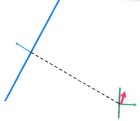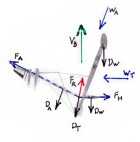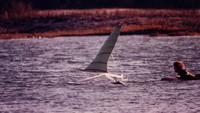High-Speed Sailing
| Vessel Name: | Sailien |
| Vessel Make/Model: | Experimental/custom |
28 September 2013
The America’s Cup
I watched, with interest, the videos of the 34th America’s Cup. At last we have fast sailboats engaged in a competition that is fun to watch. The virtual images (such as course boundaries, distance grid lines, separation between boats, etc.) overlaid on the real images really helps to keep the race [...]
31 August 2013
100 Knots for Hydroptere?
The latest news from Hydroptere is that they have plans for a 100 knot sailboat. This was posted on 26 Aug 2013, so look for that date at this address. http://hydroptere.com/en/the-news/last-news/
17 November 2012
Aptly named Sailrocket, blasts off!
While yet to be ratified, Sailrocket posted an average speed over 500 meters of 59 knots. I will not be surprised if they increase their record into the 60 knot range during this record attempt.
02 January 2012
More drag for VSR2?
I want to start by pointing out that the whole VSR2 team has done a stellar job and has demonstrated conclusively that the forces that drive a sailboat can be aligned for roll stability without using ballast and without using any down-force. (Trifoiler achieved roll stability by using down-force, but [...]
18 December 2011
My analysis of Sailrocket
I copied a diagram of VSR2 (wing doesn’t show well) and added in the major force arrows that apply. Be aware that these arrows are not correct in terms of scale (length) and some of their locations are guesses, however I believe I’m correct enough for us to learn something about what VSR2 has been [...]
23 October 2011
60 is within reach, what’s next?
I have been watching Sailrocket’s progress with great interest and there’s no question they have a winner. I fully expect to see them reach 60kt in the near future. Sailrocket has now demonstrated what I first learned with my models and again with my full-sized prototypes, that if you get the forces [...]
Monofoil sailing
We can learn some interesting things from the video clips. The clips show both starboard and port tacks, and I like that because they're working toward a practical craft. Also shown is the craft in planing mode and in "flying" mode, so we can see its performance potential. There is, however, an extremely interesting clip of the model flipping; we can learn a lot from that. This clip is titled "Monofoil, wind gradient crash" and I'll explain why the craft flipped a bit differently than the text which starts with: "A model testing problem" (be sure to click the button to get the complete text).
Here we go: the explanation given for the model's flip is that as it rose up into "flying" mode, the stronger wind at the higher elevation generated more force, causing the flip. The explanation is correct, but it is looking at the problem from the wrong direction and it will get you in trouble. Note that the explanation also states that the force increase is more significant for a model than for a full scale boat. While that may be true, it still shows that there will be a stability problem with a full size craft.
I'm going to be referring to the diagrams on Monofoil's website (use my link). On their site, go to the page "Design", which has the diagrams. (Either work off your monitor or print a copy of the diagrams.) Extend the "lift" arrow and the "foil reaction" arrow back toward each other until they intersect. (The edge of a piece of paper works great against your monitor's image.) At the point of intersection (just below the airfoil) is where the resultant force will act. Represent this force with a small arrow, which points up and left toward the wing tip. This resultant force is the force that lifts the hull of the craft out of the water into "flying" mode; it has to be greater than the weight of the craft to do so. However, while the weight of the craft does not change when sailing, the wind force is constantly changing, therefore the lift force, the foil reaction force and the resultant force are also constantly changing. This is an unstable condition that the crew must constantly correct for (in strong winds) or the craft will flip, as we see in the video. Note that this is essentially the same as Sailien force diagram #2 (post of 12 Dec 08).
On Sailien, I align the "lift" force and the "foil reaction" force, using them only to drive the boat, and I use hydrofoils or planing devices to lift the craft reducing the water's drag. Since the craft always remains stable, it can take "any" amount of wind force (within the limits of structural strength and sea state).
Bob
About & Links
- Bob's Surfing Blog
- Bob's Website
- Greenbird (Windjet)
- l'Hydroptere
- Le Projet Dared
- Macquarie Speed Sailing Team
- Monofoil Sailing
- Mountain Goat STOL
- Mr Smith's Amazing Sailboats
- Patent Office (Search)
- Radboat
- Sailien Prototypes (early), Delta, etc.
- Sailien Video
- Sailien Website
- The Basics of Surfboard Design
- The Basics of Surfboard Design en Espanol
- The Swedish Speed-Sailing Challenge
- Trifoiler
- Vestas Sailrocket
- Windjet Project
- WSSRC


